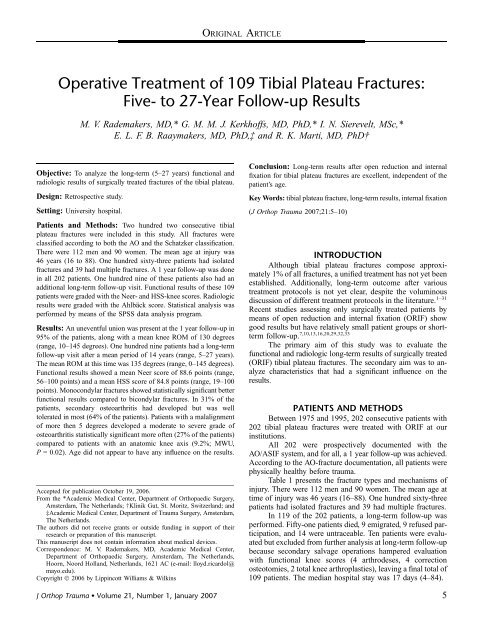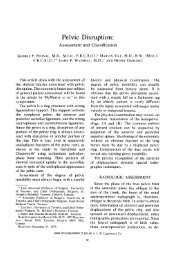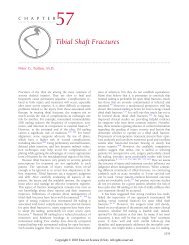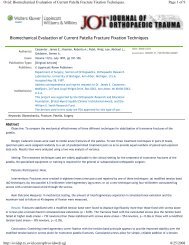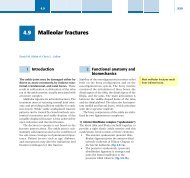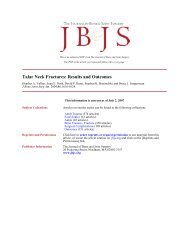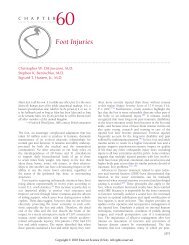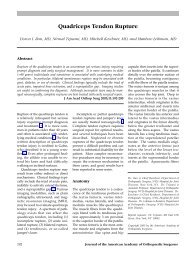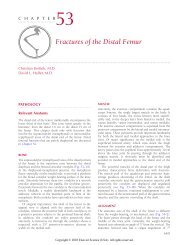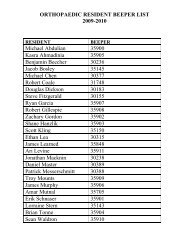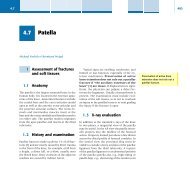Operative Treatment of 109 Tibial Plateau Fractures ... - ResearchGate
Operative Treatment of 109 Tibial Plateau Fractures ... - ResearchGate
Operative Treatment of 109 Tibial Plateau Fractures ... - ResearchGate
You also want an ePaper? Increase the reach of your titles
YUMPU automatically turns print PDFs into web optimized ePapers that Google loves.
ORIGINAL ARTICLE<br />
<strong>Operative</strong> <strong>Treatment</strong> <strong>of</strong> <strong>109</strong> <strong>Tibial</strong> <strong>Plateau</strong> <strong>Fractures</strong>:<br />
Five- to 27-Year Follow-up Results<br />
M. V. Rademakers, MD,* G. M. M. J. Kerkh<strong>of</strong>fs, MD, PhD,* I. N. Sierevelt, MSc,*<br />
E. L. F. B. Raaymakers, MD, PhD,‡ and R. K. Marti, MD, PhD†<br />
Objective: To analyze the long-term (5–27 years) functional and<br />
radiologic results <strong>of</strong> surgically treated fractures <strong>of</strong> the tibial plateau.<br />
Design: Retrospective study.<br />
Setting: University hospital.<br />
Patients and Methods: Two hundred two consecutive tibial<br />
plateau fractures were included in this study. All fractures were<br />
classified according to both the AO and the Schatzker classification.<br />
There were 112 men and 90 women. The mean age at injury was<br />
46 years (16 to 88). One hundred sixty-three patients had isolated<br />
fractures and 39 had multiple fractures. A 1 year follow-up was done<br />
in all 202 patients. One hundred nine <strong>of</strong> these patients also had an<br />
additional long-term follow-up visit. Functional results <strong>of</strong> these <strong>109</strong><br />
patients were graded with the Neer- and HSS-knee scores. Radiologic<br />
results were graded with the Ahlbäck score. Statistical analysis was<br />
performed by means <strong>of</strong> the SPSS data analysis program.<br />
Results: An uneventful union was present at the 1 year follow-up in<br />
95% <strong>of</strong> the patients, along with a mean knee ROM <strong>of</strong> 130 degrees<br />
(range, 10–145 degrees). One hundred nine patients had a long-term<br />
follow-up visit after a mean period <strong>of</strong> 14 years (range, 5–27 years).<br />
The mean ROM at this time was 135 degrees (range, 0–145 degrees).<br />
Functional results showed a mean Neer score <strong>of</strong> 88.6 points (range,<br />
56–100 points) and a mean HSS score <strong>of</strong> 84.8 points (range, 19–100<br />
points). Monocondylar fractures showed statistically significant better<br />
functional results compared to bicondylar fractures. In 31% <strong>of</strong> the<br />
patients, secondary osteoarthritis had developed but was well<br />
tolerated in most (64% <strong>of</strong> the patients). Patients with a malalignment<br />
<strong>of</strong> more then 5 degrees developed a moderate to severe grade <strong>of</strong><br />
osteoarthritis statistically significant more <strong>of</strong>ten (27% <strong>of</strong> the patients)<br />
compared to patients with an anatomic knee axis (9.2%; MWU,<br />
P = 0.02). Age did not appear to have any influence on the results.<br />
Accepted for publication October 19, 2006.<br />
From the *Academic Medical Center, Department <strong>of</strong> Orthopaedic Surgery,<br />
Amsterdam, The Netherlands; †Klinik Gut, St. Moritz, Switzerland; and<br />
‡Academic Medical Center, Department <strong>of</strong> Trauma Surgery, Amsterdam,<br />
The Netherlands.<br />
The authors did not receive grants or outside funding in support <strong>of</strong> their<br />
research or preparation <strong>of</strong> this manuscript.<br />
This manuscript does not contain information about medical devices.<br />
Correspondence: M. V. Rademakers, MD, Academic Medical Center,<br />
Department <strong>of</strong> Orthopaedic Surgery, Amsterdam, The Netherlands,<br />
Hoorn, Noord Holland, Netherlands, 1621 AC (e-mail: lloyd.ricardol@<br />
mayo.edu).<br />
Copyright Ó 2006 by Lippincott Williams & Wilkins<br />
Conclusion: Long-term results after open reduction and internal<br />
fixation for tibial plateau fractures are excellent, independent <strong>of</strong> the<br />
patient’s age.<br />
Key Words: tibial plateau fracture, long-term results, internal fixation<br />
(J Orthop Trauma 2007;21:5–10)<br />
INTRODUCTION<br />
Although tibial plateau fractures compose approximately<br />
1% <strong>of</strong> all fractures, a unified treatment has not yet been<br />
established. Additionally, long-term outcome after various<br />
treatment protocols is not yet clear, despite the voluminous<br />
discussion <strong>of</strong> different treatment protocols in the literature. 1–31<br />
Recent studies assessing only surgically treated patients by<br />
means <strong>of</strong> open reduction and internal fixation (ORIF) show<br />
good results but have relatively small patient groups or shortterm<br />
follow-up. 7,10,13,16,20,29,32,33<br />
The primary aim <strong>of</strong> this study was to evaluate the<br />
functional and radiologic long-term results <strong>of</strong> surgically treated<br />
(ORIF) tibial plateau fractures. The secondary aim was to analyze<br />
characteristics that had a significant influence on the<br />
results.<br />
PATIENTS AND METHODS<br />
Between 1975 and 1995, 202 consecutive patients with<br />
202 tibial plateau fractures were treated with ORIF at our<br />
institutions.<br />
All 202 were prospectively documented with the<br />
AO/ASIF system, and for all, a 1 year follow-up was achieved.<br />
According to the AO-fracture documentation, all patients were<br />
physically healthy before trauma.<br />
Table 1 presents the fracture types and mechanisms <strong>of</strong><br />
injury. There were 112 men and 90 women. The mean age at<br />
time <strong>of</strong> injury was 46 years (16–88). One hundred sixty-three<br />
patients had isolated fractures and 39 had multiple fractures.<br />
In 119 <strong>of</strong> the 202 patients, a long-term follow-up was<br />
performed. Fifty-one patients died, 9 emigrated, 9 refused participation,<br />
and 14 were untraceable. Ten patients were evaluated<br />
but excluded from further analysis at long-term follow-up<br />
because secondary salvage operations hampered evaluation<br />
with functional knee scores (4 arthrodeses, 4 correction<br />
osteotomies, 2 total knee arthroplasties), leaving a final total <strong>of</strong><br />
<strong>109</strong> patients. The median hospital stay was 17 days (4–84).<br />
J Orthop Trauma Volume 21, Number 1, January 2007 5
Rademakers et al J Orthop Trauma Volume 21, Number 1, January 2007<br />
FIGURE 1. Case 1. A 34-year-old man who sustained a 41C3 fracture <strong>of</strong> the right leg as a result <strong>of</strong> a motor vehicle crash. A, Injury<br />
anteroposterior radiograph. B, Postoperative anteroposterior radiograph. ORIF was done and intrinsic stability was created by<br />
a cancellous bone graft. C, D, Anteroposterior and lateral radiographs 21 years after surgery. This patient had an excellent result<br />
both for the Neer and HSS knee score (86 and 89, respectively), and there were no signs <strong>of</strong> secondary osteoarthritis. The patient<br />
desired the hardware to be removed several years after surgery, though no pain was present.<br />
<strong>Operative</strong> Technique<br />
All patients were treated by ORIF performed by 12<br />
surgeons. Indications for surgical treatment were a displacement<br />
<strong>of</strong> the tibial plateau <strong>of</strong> at least 5 mm or a fracture-related<br />
clinical instability <strong>of</strong> at least 5 degrees.<br />
Patients were placed in the supine position, with the ability<br />
to bring the knee to 90 degrees <strong>of</strong> flexion. For unicondylar<br />
fractures, a straight parapatellar incision was used for fracture<br />
exposure. After arthrotomy and extensive rinsing, the knee<br />
joint was inspected for fracture patterns and damage <strong>of</strong> the<br />
meniscus and ligaments. The anterior horn <strong>of</strong> the meniscus<br />
was released to improve exposure and reinserted after fixation<br />
<strong>of</strong> the fracture. No meniscectomy was performed. Cruciate<br />
ligament avulsions were reattached by cerclage fixation. After<br />
anatomic reduction, screw or plate fixation was used to stabilize<br />
the fracture. Pure split fractures were fixed by screws and<br />
antisliding washers. When additional support <strong>of</strong> the fracture<br />
area was mandatory, an L-, T-, or semitubular plate was used<br />
for buttressing. Impaction fractures were treated by elevating<br />
the fragments from below with a bone impactor introduced<br />
through the fracture or through a small cortical window. The<br />
remaining bony defect was filled with autologous cancellous<br />
bone grafts from the ipsilateral iliac crest, supported by screw<br />
fixation through a buttress plate.<br />
In bicondylar fractures, an additional medial incision<br />
was made to facilitate anatomic reduction and buttressing<br />
<strong>of</strong> the medial fragment. Thereafter, the lateral condyle could<br />
be adapted to the anatomically reduced medial condyle. Exceptionally,<br />
an osteotomy <strong>of</strong> Gerdy tubercle or fibular head<br />
was used to reduce posterolateral impression fractures. 31 Postoperative<br />
active and passive motion was started as soon as<br />
possible.<br />
Follow-up<br />
One hundred nine patients were treated at the outpatient<br />
clinic; they were asked to fill in a questionnaire (Neer- and<br />
HSS-knee score), a physical examination was performed, and<br />
radiographs were made (full-length standing views: AP, lateral,<br />
and oblique). Knee laxity was tested manually by the same<br />
2 main investigators. Trauma radiographs were classified<br />
according to both the AO and the Schatzker classification. 27<br />
Functional status at follow-up was evaluated using the Neer<br />
score 34 and HSS knee score. 35 The Ahlbäck score 36 was used<br />
for radiologic evaluation. Assessment <strong>of</strong> radiologic alignment<br />
and joint congruency was performed manually by analysis <strong>of</strong><br />
both left and right 3-directional radiographs. A malunion was<br />
defined as an unacceptable axial alignment (varus/valgus .5<br />
degrees, rotation .10 degrees, shortening .2 cm) after full<br />
consolidation. Scoring was performed by 2 authors not involved<br />
in the initial treatment (resident orthopedic surgeons).<br />
TABLE 1. Fracture Characteristics<br />
Fracture<br />
Type<br />
Motor<br />
Vehicle<br />
Crash<br />
Pedestrian<br />
Mechanism <strong>of</strong> Injury<br />
Sports<br />
Trauma<br />
Domestic<br />
Total<br />
(%)<br />
41 B1 11 4 12 21 48 (24)<br />
41 B2 6 2 5 9 22 (11)<br />
41 B3 19 12 15 23 69 (34)<br />
41 C1 15 4 3 3 25 (12)<br />
41 C2 11 3 1 0 15 (8)<br />
41 C3 16 4 1 2 23 (11)<br />
Total (%) 78 (39) 29 (14) 37 (18) 58 (29) 202 (100)<br />
6 q 2006 Lippincott Williams & Wilkins
J Orthop Trauma Volume 21, Number 1, January 2007<br />
<strong>Operative</strong> <strong>Treatment</strong> <strong>of</strong> <strong>109</strong> <strong>Tibial</strong> <strong>Plateau</strong> <strong>Fractures</strong><br />
Statistical Analysis<br />
Data were analyzed by using 1-way analysis <strong>of</strong> variance<br />
and Student t tests. Correlations were analysed using the<br />
Pearson correlation coefficient. The x 2 test was used for<br />
dichotomous variables. Statistical significance was determined<br />
at a P , 0.05 level.<br />
RESULTS<br />
One-Year Results<br />
At 1 year follow-up, 192 <strong>of</strong> the 202 patients (95%)<br />
showed an uneventful consolidation <strong>of</strong> the fracture, and 10<br />
patients (5%) had a complication <strong>of</strong> fracture healing (nonunion<br />
or malunion). The mean knee ROM was 130 degrees (10–145<br />
degrees). Working and sports activities were resumed in <strong>109</strong><br />
(91%) and 75 patients (76%), respectively.<br />
Complications (for 202 Patients)<br />
Eleven patients (5.4%) developed a deep wound<br />
infection within the first 2 weeks after treatment and were<br />
treated by surgical debridement. Nine fully recovered. In the<br />
remaining 2 patients, recurrent infections led to impaired<br />
fracture healing (non-union) and finally an arthrodesis.<br />
In 8 patients (4.0%), a malunion <strong>of</strong> the fracture<br />
developed. Two asymptomatic patients decided not to be<br />
treated. In 6 patients, there was a progressive valgus malalignment,<br />
with secondary osteoarthritis. Reconstructive correction<br />
osteotomy 37 was performed in 4 patients and an arthrodesis in 2.<br />
Two patients with severe secondary osteoarthritis<br />
received a total knee arthroplasty.<br />
The 10 patients treated with an arthrodesis, a correction<br />
osteotomy, or a total knee arthroplasty were rated as failures<br />
(5%) and were excluded from further long-term analysis.<br />
Long-Term Results (for <strong>109</strong> Patients)<br />
Mean follow-up <strong>of</strong> <strong>109</strong> patients (54% eligible patients)<br />
was 14 years (range, 5–27 years).<br />
Functional Results<br />
The mean ROM was 135 degrees (0–145 degrees).<br />
Eighty-nine <strong>of</strong> the patients (82%) showed no anteroposterior<br />
laxity (,5 mm ); 18 (17%), a clinical laxity <strong>of</strong> 5 to 10 mm; and<br />
2 (1%), a laxity <strong>of</strong> greater than 10 mm. In 104 patients (95%),<br />
no collateral instability was found (,5 degrees), and in 5 (5%)<br />
clinical instability measured between 6 and 9 degrees.<br />
Neer Score. The mean Neer score was 88.6 points<br />
(56–100 points). Seventy-six patients (69.7%) were rated as<br />
excellent, 27 (24.8%) good, and 6 (5.5%) fair.<br />
HSS Knee Score. The mean HSS knee score was 84.8<br />
points (19–100 points). Sixty-eight patients (62.4%) were<br />
rated as excellent, 23 (21.1%) good, 10 (9.2%) fair, and 8<br />
(7.3%) poor.<br />
Radiologic Results<br />
Seventy-five patients (69%) showed no signs <strong>of</strong><br />
secondary osteoarthritis (grade 0); 23 (21%), slight signs<br />
(grade 1); 8 (7%), moderate signs (grade 2); and 3 (3%), severe<br />
signs (grade 3). Seven <strong>of</strong> the 11 patients (64%) with<br />
a moderate to severe grade <strong>of</strong> secondary osteoarthritis had<br />
a good to excellent Neer score, and 5 (46%) had a good to<br />
excellent HSS knee score.<br />
Correlations<br />
All <strong>109</strong> patients who had a follow-up visit were analyzed<br />
for predictor variables influencing the long-term results.<br />
Range <strong>of</strong> Motion<br />
Correlation between mean ROM at 1 year follow-up and<br />
latest follow-up was 0.63 (P , 0.001). Mean difference between<br />
the ROM at 1 year and at latest follow-up was 5 degrees<br />
(P , 0.001).<br />
Fracture Type<br />
For monocondylar type B fractures, 70 patients<br />
sustained a fracture <strong>of</strong> the lateral condyle (Schatzker 1/2/3)<br />
and 7 (9%) a fracture <strong>of</strong> the medial condyle (Schatzker 4). No<br />
statistically significant functional differences were observed<br />
when medial and lateral fractures were compared (MWU; P ¼<br />
0.90 and 0.32).<br />
Monocondylar fractures had a statistically better Neer<br />
score compared to bicondylar fractures (MWU; P ¼ 0.04).<br />
Mean Neer score for monocondylar fractures was 93 (40–100)<br />
and for bicondylar fractures, 87 (42–100). No correlation was<br />
found between fracture type, HSS knee score (MWU; P ¼ 0.08),<br />
and Ahlbäck score (MWU; P ¼ 0.57).<br />
Mean Neer and HSS knee score for the most complicated<br />
fracture pattern, AO type 41C3 or Schatzker type 6 fractures<br />
(n ¼ 15, or 14%), was 81.5 (42–94) and 80.2 (25–100),<br />
respectively.<br />
Age at Trauma<br />
Age at time <strong>of</strong> trauma did not correlate (correlation<br />
coefficient 0.27, P ¼ 0.004) with Neer score or HSS knee<br />
score (correlation coefficient, 0.19; P = 0.043). Also, the<br />
Ahlbäck score did not correlate with age at time <strong>of</strong> trauma<br />
(MWU; P ¼ 0.25).<br />
Duration <strong>of</strong> Follow-up<br />
No correlation was found between duration <strong>of</strong> follow-up<br />
and either Neer or HSS knee score (correlation coefficient, 0.1;<br />
P ¼ 0.29 and 0.04, P ¼ 0.70, respectively). Also, the Ahlbäck<br />
score did not correlate with the duration <strong>of</strong> follow-up (MWU;<br />
P ¼ 0.88).<br />
Knee Stability<br />
Patients with an anteroposterior laxity greater than or<br />
equal to 10 mm (n ¼ 2) did not have a higher Ahlbäck score<br />
compared to those with a laxity less than 10 mm (n ¼ 107,<br />
MWU; P ¼ 0.08). Patients with a collateral instability <strong>of</strong><br />
6 degrees to 9 degrees (n ¼ 9) did not score higher on the<br />
Ahlbäck score compared to those with an instability less than<br />
or equal to 5 degrees (n ¼ 100, MWU; P ¼ 0.08).<br />
Anatomic Reduction<br />
A step-<strong>of</strong>f greater than 2 and less than or equal to 4 mm<br />
(n ¼ 8) did not show a statistically significant difference in<br />
development <strong>of</strong> secondary osteoarthritis compared to a step<strong>of</strong>f<br />
less than or equal to 2 mm (n ¼ 101, MWU; P ¼ 0.43).<br />
q 2006 Lippincott Williams & Wilkins 7
Rademakers et al J Orthop Trauma Volume 21, Number 1, January 2007<br />
None <strong>of</strong> the patients had an articular step-<strong>of</strong>f greater than 4 mm.<br />
Patients with a condylar widening greater than 5 mm (n ¼ 3)<br />
did not reveal statistically significantly different results compared<br />
to condylar widening less than or equal to 5 mm (n ¼ 106,<br />
MWU; P =0.95).<br />
Axial Alignment<br />
Eighty-three patients (74%) showed equal alignment <strong>of</strong><br />
the injured leg compared to the contralateral side, 18 (18%)<br />
showed a valgus or varus malalignment <strong>of</strong> less than 5 degrees,<br />
and 8 (7.3%), a malalignment between 5 degrees and 10 degrees.<br />
Patients with a malalignment <strong>of</strong> more than 5 degrees<br />
developed a moderate to severe grade <strong>of</strong> osteoarthritis statistically<br />
significant more <strong>of</strong>ten (27% <strong>of</strong> the patients) compared to<br />
patients with an anatomic knee axis (9.2%; MWU P ¼ 0.02).<br />
Degree <strong>of</strong> Secondary Osteoarthritis Versus<br />
Knee Function<br />
Patients without signs <strong>of</strong> secondary osteoarthritis had<br />
a statistically significantly higher Neer and HSS knee score<br />
compared to patients with moderate to severe development<br />
<strong>of</strong> secondary osteoarthritis (MWU; P ¼ 0.007, P ¼ 0.001,<br />
respectively).<br />
DISCUSSION<br />
Optimal treatment <strong>of</strong> tibial plateau fractures has been an<br />
issue <strong>of</strong> discussion for several decades. 1–31 Extensive research<br />
has been performed analyzing functional and radiologic results<br />
for nonoperative, as well as surgical, treatment methods.<br />
Nonoperative treatment is advised for minimally displaced<br />
closed fractures. Surgical treatment is advised for fractures<br />
with greater than 5 mm displacement or greater than 5 degrees’<br />
instability with varus or valgus stress. During the last decade,<br />
studies analyzing surgically treated tibial plateau fractures<br />
have shown good results. 7,10,13,16,20,29,32,33 However, because<br />
these studies <strong>of</strong>ten were small groups <strong>of</strong> patients or relatively<br />
short-term follow-up, a clear prognosis on long-term outcome<br />
cannot be provided. In this study, we analyzed the long-term<br />
functional and radiologic results <strong>of</strong> surgically treated (ORIF)<br />
tibial plateau fractures and predictor factors influencing these<br />
results.<br />
Our results show that surgical treatment (ORIF) leads to<br />
excellent functional and radiologic results. Continual monitoring<br />
<strong>of</strong> these patients made it possible to assess the<br />
progression <strong>of</strong> the knee function closely. Most patients have<br />
resumed their daily activities as before the trauma and have<br />
regained almost full flexion and extension <strong>of</strong> the knee joint<br />
1 year after treatment. After an average <strong>of</strong> 14 years’ follow-up,<br />
excellent results were observed in the majority <strong>of</strong> these<br />
patients. In comparing short-term to long-term results, the<br />
knee function is not likely to change significantly after 1 year.<br />
Given this fact, we believe that results at 1 year are a good<br />
prognostic indicator for future knee function.<br />
Several predictor variables influencing results after<br />
treatment have been described in the literature. Hsu et al 13<br />
performed a study on 20 surgically treated patients with<br />
a mean age at trauma <strong>of</strong> 66 years and follow-up <strong>of</strong> 50 months.<br />
Using the modified Rasmussen score, they found satisfactory<br />
results in 90% <strong>of</strong> the patients. Their conclusion was that for<br />
elderly patients, the basic principles for surgical treatment are<br />
the same as for young patients, though a more conservatively<br />
orientated rehabilitation program is mandatory. Biyani et al 7<br />
performed a similar study with 32 patients with a mean age at<br />
trauma <strong>of</strong> 72 years and a mean follow-up <strong>of</strong> 3.7 years. Using<br />
the Rasmussen score, satisfactory results were observed in<br />
90% <strong>of</strong> the patients. They concluded that satisfactory results<br />
can be obtained in carefully selected patients. In our study, no<br />
correlation was found between age and functional or radiologic<br />
results; excellent results were obtained in the majority <strong>of</strong> the<br />
patients through the entire age spectrum.<br />
Our study showed that fracture type influences the<br />
functional results significantly (P ¼ 0.04). Bicondylar fractures<br />
tend to show less favourable, though still good, results<br />
compared to monocondylar fractures. Only a relatively small<br />
percentage <strong>of</strong> the patients in our study (14%) had the most<br />
complicated fracture pattern, AO type 41C3 or Schatzker type<br />
6 fractures. In our opinion, this is because a great deal <strong>of</strong> our<br />
study population incurred their fracture years ago when highenergy<br />
traffic accidents were less common. We are aware <strong>of</strong><br />
the fact that this relatively low incidence <strong>of</strong> high-energy fractures<br />
increases the change <strong>of</strong> skewing the functional outcomes,<br />
though in our study these patients still scored a good result.<br />
Previous studies reported the importance <strong>of</strong> stability <strong>of</strong><br />
the knee after treatment <strong>of</strong> tibia plateau fractures as one <strong>of</strong> the<br />
most important predictors for future knee function. 38 This<br />
underlines the main goal <strong>of</strong> treatment with ORIF, namely, to<br />
create a stable and painless knee joint. Our study showed that<br />
after ORIF, good stability in an anteroposterior, as well as<br />
a mediolateral, direction is obtained in the majority <strong>of</strong> patients.<br />
No significant correlations were found between stability and<br />
the final results, but this is probably mainly because only<br />
a small number <strong>of</strong> patients had a significant laxity.<br />
The incidence <strong>of</strong> s<strong>of</strong>t-tissue injuries in tibial plateau<br />
fractures is high. In a prospective cohort study performed by<br />
Gardner et al 39 103 patients with tibial plateau fractures were<br />
evaluated for s<strong>of</strong>t-tissue injuries by MRI. They found that only<br />
1% showed complete absence <strong>of</strong> s<strong>of</strong>t-tissue injuries, and<br />
meniscal injuries were present in up to 91% <strong>of</strong> all patients.<br />
Shepherd et al 40 showed a high prevalence <strong>of</strong> s<strong>of</strong>t-tissue<br />
injuries even in minimally displaced tibial plateau fractures.<br />
The treatment <strong>of</strong> these s<strong>of</strong>t-tissue injuries has been a debate for<br />
several decades. It has become commonplace to create a stable<br />
knee, ensuring early exercise and restoration <strong>of</strong> knee function<br />
and minimizing the development <strong>of</strong> secondary osteoarthritis in<br />
the long term. Honkonen, 41 in a 1994 article, described posttraumatic<br />
osteoarthritis to be present in 44% <strong>of</strong> 131 cases.<br />
Patients who underwent a meniscectomy showed a greater<br />
prevalence <strong>of</strong> posttraumatic osteoarthritis (74%) compared to<br />
patients whose meniscus was reattached (37%), which<br />
furthermore implies the need for repair <strong>of</strong> s<strong>of</strong>t-tissue damage.<br />
Secondary osteoarthritis remains a problem after intraarticular<br />
fractures <strong>of</strong> the knee. Marsh et al 38 performed<br />
a review concerning the importance <strong>of</strong> anatomic reduction<br />
with respect to articular fractures. They found that there is little<br />
rationale for the premise that an anatomic reduction <strong>of</strong> the<br />
articular surface is associated with obtaining a good clinical<br />
outcome. They also stated that the cartilage injury sustained by<br />
8 q 2006 Lippincott Williams & Wilkins
J Orthop Trauma Volume 21, Number 1, January 2007<br />
<strong>Operative</strong> <strong>Treatment</strong> <strong>of</strong> <strong>109</strong> <strong>Tibial</strong> <strong>Plateau</strong> <strong>Fractures</strong><br />
the initial injury may be the most important factor that leads to<br />
joint degeneration despite accurate reduction. Furthermore,<br />
they underlined the fact that malalignment after treatment<br />
contributes to a poor outcome after tibial plateau fractures.<br />
In our study, a moderate to severe degree <strong>of</strong> posttraumatic<br />
osteoarthritis was present in 11% <strong>of</strong> all patients and<br />
varus or valgus malalignment was a good predictor variable<br />
for the development <strong>of</strong> secondary osteoarthritis. Secondary<br />
arthritis developed in 9.2% <strong>of</strong> the patients with a near anatomic<br />
knee axis and in 27% <strong>of</strong> the patients with a malalignment <strong>of</strong><br />
5 degrees or more (P = 0.02).<br />
Our results also show a strong correlation between the<br />
development <strong>of</strong> secondary osteoarthritis and the functional<br />
results at follow-up. Patients with no or mild secondary<br />
osteoarthritis had good to excellent functional results in most<br />
cases, whereas patients with a higher degree <strong>of</strong> secondary<br />
osteoarthritis have a greater risk <strong>of</strong> developing less optimal<br />
functional results. However, almost half <strong>of</strong> the patients with<br />
a moderate to severe grade <strong>of</strong> secondary osteoarthritis still had<br />
good to excellent functional results.<br />
Wound infections remain a serious problem in the<br />
treatment <strong>of</strong> tibia plateau fractures, with infection rates ranging<br />
from 3% to 32%. 6,8,14,18,20,22,27,42–44 Barei et al 45 performed<br />
a study analyzing the complications after ORIF with a<br />
2-incision technique in patients with high-energy tibial plateau<br />
fractures. In 8.4% <strong>of</strong> 83 patients, a deep wound infection developed<br />
that required an average <strong>of</strong> 3.3 additional procedures to<br />
clinical resolution. They state that with proper timing <strong>of</strong> the<br />
internal fixation and precise tissue handling, high-energy tibial<br />
plateau fractures can be safely treated by dual plating. In our<br />
study, it became apparent that when both the incision and<br />
amount <strong>of</strong> metal used were minimized, complications were not<br />
frequent. Less invasive surgery <strong>of</strong> tibial plateau fractures has<br />
recently been developed to overcome this problem and appears<br />
to show satisfactory early results, with infection rates between<br />
3.7% and 13.3%. 46–48 Future analysis has to prove that the<br />
long-term results with less invasive surgery are equal to those<br />
obtained with formal ORIF.<br />
The authors recognize the retrospective nature <strong>of</strong> this<br />
study as a limitation but believe that the long-term follow-up<br />
<strong>of</strong> this large patient population does provide useful information<br />
about ORIF <strong>of</strong> tibial plateau fractures.<br />
CONCLUSION<br />
In our experience, careful open surgical reduction and<br />
stable internal fixation <strong>of</strong> tibial plateau fractures shows excellent<br />
functional and radiologic results at long-term follow-up.<br />
Previous literature on this subject has described short- and<br />
medium-term follow-up, but this study shows that the majority<br />
<strong>of</strong> the patients regain excellent knee function during an average<br />
<strong>of</strong> 14 years’ follow-up post surgery. Therefore, for patients<br />
with tibial plateau fractures who have a displacement <strong>of</strong> the<br />
tibial plateau <strong>of</strong> at least 5 mm or a fracture-related clinical instability<br />
<strong>of</strong> at least 5 degrees, we recommend treatment by<br />
ORIF. Last, the functional scores <strong>of</strong> the injured knee 1 year<br />
postoperatively adequately predict future knee function for<br />
years to come.<br />
REFERENCES<br />
1. Carlson DA. Posterior bicondylar tibial plateau fractures. J Orthop<br />
Trauma. 2005;19:73–78.<br />
2. Ebraheim NA, Sabry FF, Haman SP. Open reduction and internal<br />
fixation <strong>of</strong> 117 tibial plateau fractures. Orthopedics. 2004;27:1281–1287.<br />
3. Piper KJ, Won HY, Ellis AM. Hybrid external fixation in complex tibial<br />
plateau and plafond fractures: an Australian audit <strong>of</strong> outcomes. Injury.<br />
2005;36:178–184.<br />
4. Katsenis D, Vasilis A, Panayiotis M, et al. Minimal internal fixation<br />
augmented by small wire transfixion frames for high-energy tibial plateau<br />
fractures. J Orthop Trauma. 2005;19:241–248.<br />
5. El Barbary H, Abdel GH, Misbah H, et al. Complex tibial plateau<br />
fractures treated with Ilizarov external fixator with or without minimal<br />
internal fixation. Int Orthop. 2005;29:182–185.<br />
6. Benirschke SK, Agnew SG, Mayo KA, et al. Immediate internal fixation<br />
<strong>of</strong> open, complex tibial plateau fractures: treatment by a standard protocol.<br />
J Orthop Trauma. 1992;6:78–86.<br />
7. Biyani A, Reddy NS, Chaudhury J, et al. The results <strong>of</strong> surgical<br />
management <strong>of</strong> displaced tibial plateau fractures in the elderly. Injury.<br />
1995;26:291–297.<br />
8. Boszotta H, Helperstorfer W, Kolndorfer G, et al. [Long-term results <strong>of</strong><br />
surgical management <strong>of</strong> tibial head fractures]. Aktuelle Traumatol. 1993;<br />
23:178–182.<br />
9. Gausewitz S, Hohl M. The significance <strong>of</strong> early motion in the treatment <strong>of</strong><br />
tibial plateau fractures. Clin Orthop Relat Res. 1986;135–138.<br />
10. Gerich T, Blauth M, Witte F, et al. [Osteosynthesis <strong>of</strong> fractures <strong>of</strong> the<br />
head <strong>of</strong> the tibia in advanced age: a matched-pair analysis]. Unfallchirurg.<br />
2001;104:50–56.<br />
11. Glauser T, Abdel Baki GR, Noesberger B. [Long-term results <strong>of</strong><br />
surgically treated tibial plateau fractures]. Helv Chir Acta. 1987;54:477–<br />
481.<br />
12. Honkonen SE. Indications for surgical treatment <strong>of</strong> tibial condyle<br />
fractures. Clin Orthop Relat Res. 1994;199–205.<br />
13. Hsu CJ, Chang WN, Wong CY. Surgical treatment <strong>of</strong> tibial plateau<br />
fracture in elderly patients. Arch Orthop Trauma Surg. 2001;121:67–70.<br />
14. Jensen DB, Rude C, Duus B, et al. <strong>Tibial</strong> plateau fractures: a comparison<br />
<strong>of</strong> conservative and surgical treatment. J Bone Joint Surg Br. 1990;72:<br />
49–52.<br />
15. Kiefer H, Zivaljevic N, Imbriglia JE. Arthroscopic reduction and internal<br />
fixation (ARIF) <strong>of</strong> lateral tibial plateau fractures. Knee Surg Sports<br />
Traumatol Arthrosc. 2001;9:167–172.<br />
16. Keating JF. <strong>Tibial</strong> plateau fractures in the older patient. Bull Hosp Jt Dis.<br />
1999;58:19–23.<br />
17. Koval KJ, Helfet DL. <strong>Tibial</strong> plateau fractures: evaluation and treatment.<br />
J Am Acad Orthop Surg. 1995;3:86–94.<br />
18. Lachiewicz PF, Funcik T. Factors influencing the results <strong>of</strong> open reduction<br />
and internal fixation <strong>of</strong> tibial plateau fractures. Clin Orthop Relat Res.<br />
1990;210–215.<br />
19. Lansinger O, Bergman B, Korner L, et al. <strong>Tibial</strong> condylar fractures:<br />
a twenty-year follow-up. J Bone Joint Surg Am. 1986;68:13–19.<br />
20. Levy O, Salai M, Ganel A, et al. The operative results <strong>of</strong> tibial plateau<br />
fractures in older patients: a long-term follow-up and review. Bull Hosp Jt<br />
Dis. 1993;53:15–16.<br />
21. Maheson M, Colton CL. <strong>Fractures</strong> <strong>of</strong> the tibial plateau in Nottingham.<br />
Injury. 1988;19:324–328.<br />
22. Moore TM, Patzakis MJ, Harvey JP. <strong>Tibial</strong> plateau fractures: definition,<br />
demographics, treatment rationale, and long-term results <strong>of</strong> closed traction<br />
management or operative reduction. J Orthop Trauma. 1987;1:97–119.<br />
23. Porter BB. Crush fractures <strong>of</strong> the lateral tibial table: factors influencing the<br />
prognosis. J Bone Joint Surg Br. 1970;52:676–687.<br />
24. Rasmussen PS. <strong>Tibial</strong> condylar fractures: impairment <strong>of</strong> knee joint<br />
stability as an indication for surgical treatment. J Bone Joint Surg Am.<br />
1973;55:1331–1350.<br />
25. Roberts JM. <strong>Fractures</strong> <strong>of</strong> the condyles <strong>of</strong> the tibia: an anatomical and<br />
clinical end-result study <strong>of</strong> one hundred cases. J Bone Joint Surg Am.<br />
1968;50:1505–1521.<br />
26. Roerdink WH, Oskam J, Vierhout PA. Arthroscopically assisted<br />
osteosynthesis <strong>of</strong> tibial plateau fractures in patients older than 55 years.<br />
Arthroscopy. 2001;17:826–831.<br />
27. Schatzker J, McBroom R, Bruce D. The tibial plateau fracture: the Toronto<br />
experience 1968–1975. Clin Orthop Relat Res. 1979;94–104.<br />
q 2006 Lippincott Williams & Wilkins 9
Rademakers et al J Orthop Trauma Volume 21, Number 1, January 2007<br />
28. Scheerlinck T, Ng CS, Handelberg F, et al. Medium-term results <strong>of</strong><br />
percutaneous, arthroscopically-assisted osteosynthesis <strong>of</strong> fractures <strong>of</strong> the<br />
tibial plateau. J Bone Joint Surg Br. 1998;80:959–964.<br />
29. Stevens DG, Beharry R, McKee MD, et al. The long-term functional<br />
outcome <strong>of</strong> operatively treated tibial plateau fractures. J Orthop Trauma.<br />
2001;15:312–320.<br />
30. Tscherne H, Lobenh<strong>of</strong>fer P. <strong>Tibial</strong> plateau fractures: management and<br />
expected results. Clin Orthop Relat Res. 1993;87–100.<br />
31. Waldrop JI, Macey TI, Trettin JC, et al. <strong>Fractures</strong> <strong>of</strong> the posterolateral<br />
tibial plateau. Am J Sports Med. 1988;16:492–498.<br />
32. Houben P, Wijnen R, Wildenberg F. Operatieve behandeling van<br />
tibiaplateaufracturen: resultaten op middellange termijn [Dutch]. Ned<br />
T Geneeskunde. 1995:49–53.<br />
33. Houben PF, van der Linden ES, van den Wildenberg FA, et al. Functional<br />
and radiological outcome after intra-articular tibial plateau fractures.<br />
Injury. 1997;28:459–462.<br />
34. Neer CS, Grantham SA, Shelton ML. Supracondylar fracture <strong>of</strong> the adult<br />
femur: a study <strong>of</strong> one hundred and ten cases. J Bone Joint Surg Am. 1967;<br />
49:591–613.<br />
35. Insall JN, Dorr LD, Scott RD, et al. Rationale <strong>of</strong> the Knee Society clinical<br />
rating system. Clin Orthop Relat Res. 1989;13–14.<br />
36. Ahlbäck S. Osteoarthrosis <strong>of</strong> the knee: a radiographic investigation. Acta<br />
Radiol Diagn (Stockh). 1968;(Suppl 277):7–27.<br />
37. Marti RK, Verhagen RAW. Upper tibial osteotomy for osteoarthritis <strong>of</strong> the<br />
knee. Surg Tech Orthop Traumatol. 2001;55:1–6.<br />
38. Marsh JL, Buckwalter J, Gelberman R, et al. Articular fractures: does an<br />
anatomic reduction really change the result? J Bone Joint Surg Am. 2002;<br />
84A:1259–1271.<br />
39. Gardner MJ, Yacoubian S, Geller D, et al. The incidence <strong>of</strong> s<strong>of</strong>t tissue<br />
injury in operative tibial plateau fractures: a magnetic resonance imaging<br />
analysis <strong>of</strong> 103 patients. J Orthop Trauma. 2005;19:79–84.<br />
40. Shepherd L, Abdollahi K, Lee J, et al. The prevalence <strong>of</strong> s<strong>of</strong>t tissue<br />
injuries in nonoperative tibial plateau fractures as determined by magnetic<br />
resonance imaging. J Orthop Trauma. 2002;16:628–631.<br />
41. Honkonen SE. Degenerative arthritis after tibial plateau fractures.<br />
J Orthop Trauma. 1995;9:273–277.<br />
42. Bowes DN, Hohl M. <strong>Tibial</strong> condylar fractures: evaluation <strong>of</strong> treatment and<br />
outcome. Clin Orthop Relat Res. 1982;104–108.<br />
43. Duwelius PJ, Connolly JF. Closed reduction <strong>of</strong> tibial plateau fractures:<br />
a comparison <strong>of</strong> functional and roentgenographic end results. Clin Orthop<br />
Relat Res. 1988;116–126.<br />
44. Young MJ, Barrack RL. Complications <strong>of</strong> internal fixation <strong>of</strong> tibial plateau<br />
fractures. Orthop Rev. 1994;23:149–154.<br />
45. Barei DP, Nork SE, Mills WJ, et al. Complications associated with internal<br />
fixation <strong>of</strong> high-energy bicondylar tibial plateau fractures utilizing a twoincision<br />
technique. J Orthop Trauma. 2004;18:649–657.<br />
46. Cole PA, Zlowodzki M, Kregor PJ. Less invasive stabilization system<br />
(LISS) for fractures <strong>of</strong> the proximal tibia: indications, surgical technique<br />
and preliminary results <strong>of</strong> the UMC Clinical Trial. Injury. 2003;34(Suppl 1):<br />
A16–A29.<br />
47. Schutz M, Kaab MJ, Haas N. Stabilization <strong>of</strong> proximal tibial fractures<br />
with the LIS-System: early clinical experience in Berlin. Injury. 2003;<br />
34(Suppl 1):A30–A35.<br />
48. Stannard JP, Wilson TC, Volgas DA, et al. Fracture stabilization <strong>of</strong><br />
proximal tibial fractures with the proximal tibial LISS: early experience in<br />
Birmingham, Alabama (USA). Injury. 2003;34(Suppl 1):A36–A42.<br />
10 q 2006 Lippincott Williams & Wilkins


